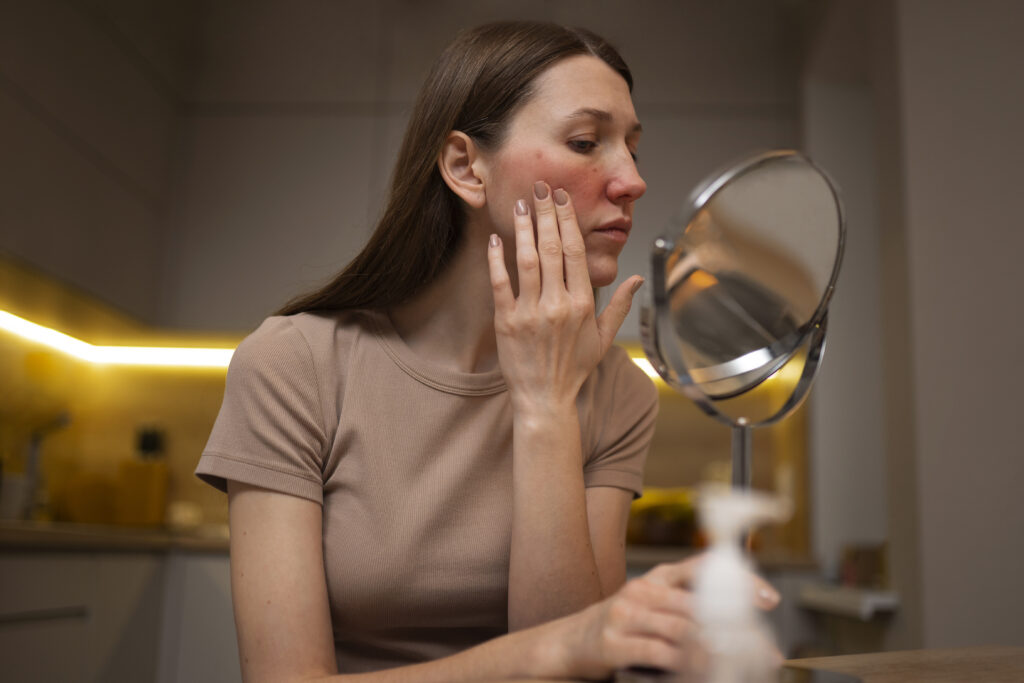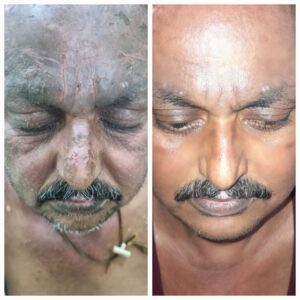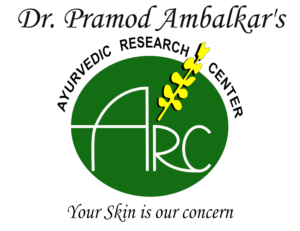- drambalkar@yahoo.co.in
- Mon - Sunday 10:00 AM - 02:00 PM
What is Airborne Contact Dermatitis (ABCD): Causes, Symptoms, Treatments
What is Airborne Contact Dermatitis (ABCD)?
Airborne Contact Dermatitis (ABCD) is a type of allergic skin reaction triggered by airborne substances that come into contact with the skin. Unlike traditional contact dermatitis, which is caused by direct contact with irritants or allergens, ABCD occurs when airborne allergens settle on the skin and provoke an immune response. This condition can be challenging to diagnose and manage due to its subtle onset and the complexity of identifying airborne triggers.

Key Characteristics of ABCD Dermatitis
- Delayed Reaction: Symptoms often develop hours to days after exposure, making it difficult to immediately link them to specific airborne allergens.
- Localized Symptoms: Commonly affects areas of the skin that are exposed to the air and allergens, though it can also occur in areas where allergens may settle indirectly.
- Chronic or Recurrent: ABCD dermatitis can be chronic, with symptoms recurring during periods of high exposure to airborne irritants or allergens.
Causes of Airborne Contact Dermatitis
Several factors can contribute to the development of ABCD dermatitis:
- Pollen: Seasonal allergens such as tree, grass, and weed pollen can cause allergic reactions when they become airborne and settle on the skin.
- Pollutants: Airborne pollutants like sulfur dioxide, nitrogen oxides, and particulate matter can irritate the skin and exacerbate dermatitis.
- Chemical Fumes: Exposure to fumes from chemicals used in industrial processes, cleaning products, or personal care products can trigger allergic reactions.
- Mold Spores: Molds, particularly those in damp or humid environments, release spores that can become airborne and provoke dermatitis in sensitive individuals.
- Environmental Allergens: Other environmental factors such as pet dander, dust mites, and pollutants can contribute to ABCD.
Airborne Contact Dermatitis Symptoms
The symptoms of ABCD dermatitis are similar to those of other forms of contact dermatitis but are often characterized by their delayed onset and specific exposure patterns. Common symptoms include:
- Redness: The skin may appear red and inflamed, particularly in areas exposed to airborne allergens.
- Itching: Intense itching or a burning sensation is common, leading to discomfort and scratching.
- Swelling: Swelling or puffiness may occur, especially in localized areas.
- Dryness and Scaling: The skin may become dry, flaky, or scaly, particularly in chronic cases.
- Blisters: In severe cases, blisters or vesicles may form, which can ooze and crust over.
Diagnosis of Airborne Contact Dermatitis
Diagnosing ABCD dermatitis can be challenging due to its delayed onset and the difficulty in pinpointing specific airborne allergens. Airborne contact dermatitis can be diagnosed by the following process involving:
- Medical History: A thorough review of the patient’s medical history, including any recent exposure to airborne allergens or irritants, helps in identifying potential triggers.
- Physical Examination: A physical examination of the affected areas of the skin is conducted to assess the severity and pattern of symptoms.
- Patch Testing: Although traditional patch testing is used to identify contact allergens, it may be less effective for airborne allergens. However, it can help rule out other types of contact dermatitis.
- Allergy Testing: Specific allergy tests, such as skin prick tests or blood tests, can help identify sensitivities to airborne allergens.
- Environmental Assessment: Evaluating the patient’s environment for potential airborne irritants or allergens can provide additional clues.
Struggling with Airborne Contact Dermatitis? Let Heal Psoriasis provide you with expert care and effective treatment solutions. Contact us today for personalized relief and start your journey to healthier skin!
Treatment and Management of Airborne Contact Dermatitis
The management of ABCD dermatitis involves a combination of avoidance strategies, symptomatic treatments, and lifestyle modifications:
- Avoidance: Identifying and minimizing exposure to airborne allergens is crucial. This may involve staying indoors during high pollen seasons, using air purifiers, and avoiding areas with high levels of pollutants.
- Topical Treatments: Topical corticosteroids or antihistamines can help reduce inflammation, itching, and swelling. For chronic cases, calcineurin inhibitors may be prescribed.
- Moisturizers: Regular use of emollients and moisturizers helps maintain skin hydration and barrier function, reducing dryness and irritation.
- Oral Medications: In severe cases, oral antihistamines or corticosteroids may be necessary to control symptoms and manage flare-ups.
- Environmental Control: Implementing measures to reduce indoor allergens, such as using HEPA filters, keeping indoor humidity levels low, and avoiding exposure to fumes and pollutants, can help prevent exacerbations.
- Skin Care Routine: Maintaining a gentle skincare routine with hypoallergenic and non-irritating products is essential for managing symptoms and preventing further irritation.
Preventive Measures For ABCD Dermatitis
Preventing ABCD involves a proactive approach to managing exposure to potential airborne allergens and irritants:
- Monitor Air Quality: Stay informed about local air quality and pollen counts, and take precautions during poor air quality days.
- Allergen-Proofing: Use allergen-proof covers for bedding and pillows, and regularly clean and vacuum to reduce indoor allergens.
- Personal Hygiene: Wash hands and face frequently to remove any airborne allergens that may have settled on the skin.
- Protective Measures: When necessary, wear protective clothing or use barriers to reduce skin contact with airborne irritants.
Before and After results of our happy patients treated from ABCD Dermatitis

Conclusion
Airborne Contact Dermatitis (ABCD) is a form of allergic skin reaction caused by airborne substances that settle on the skin. Characterized by delayed onset, localized symptoms, and potential chronicity, ABCD dermatitis requires careful management to reduce exposure to triggers and alleviate symptoms. By employing avoidance strategies, topical treatments, and lifestyle modifications, individuals can effectively manage ABCD dermatitis and improve their quality of life. Consulting with the best ayurvedic skin doctor in Mumbai for accurate diagnosis and personalized treatment is essential for managing this complex condition.

Get in Touch with us Today to Begin Your Journey of Transformation

Contact Us
- Dr.Ambalkars Aayurvedic Research Centre, ARC Bhavan, Vijay Vihar Complex, Evershine City, Last Stop, Vasai (E)
- drambalkar@yahoo.co.in
- +91 9320193201
- +91 9766362776

